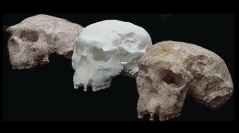

 Comptes Rendus Palevol
9 (6-7) - Pages 331-339
Comptes Rendus Palevol
9 (6-7) - Pages 331-339Recent applications of 3D virtual imaging techniques in human palaeontology have increased the possibilities and the accuracy of anthropological analysis. Two examples are given for the reconsideration of fossils discovered more than 20 years ago, thanks to this new technology. The Lower and Middle Pleistocene skulls from Yunxian and Nankin in China, which were damaged in the process of fossilization, have been virtually reconstructed. A detailed reinvestigation has been conducted by considering those reconstructed skulls and their unpublished characters (i.e., inner anatomical features inaccessible until now). The results of this analysis provide new information about the early hominids of China and contribute to the discussion of variability in Homo erectus.
Morphometrics, Diagenesis, Inner anatomical features, Homo erectus, China, 3D imaging techniques